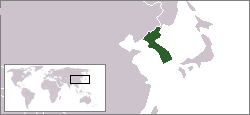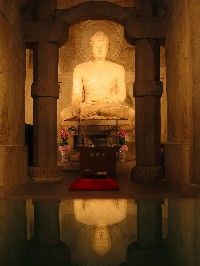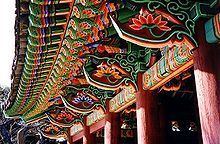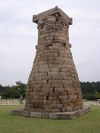Korea
| Korea | |
|---|---|

| |

| |
| Joseon royal throne |
Korea (Korean: (조선 or 한국, see below) is a geographical area, civilization, and former state situated on the Korean Peninsula in East Asia, bordering China to the northwest and Russia to the northeast, with Japan situated to the southeast across the Korea Strait.
One of the world's oldest civilizations, Korea's history begins with the founding of Gojoseon in 2333 BC, according to the Dangun legend. In the 4th century BC, the adoption of the Chinese writing system (called hanja in Korean), Buddhism, and other aspects of culture brought from ancient China had a profound effect on its society. Koreans later passed on these, as well as their own advances, to Japan, helping that country make its first steps into civilization.
After the unification of the Three Kingdoms of Korea into Unified Silla in 676, Korea was ruled by a single government and maintained political and cultural independence until the Mongol invasions of the 13th century. Korean civilization reached its height in the 15th century, during the reign of King Sejong the Great, when the Korean alphabet hangul was created.
During the latter part of the Joseon Dynasty, Korea isolated itself from the outside world and was often known as the "Hermit Kingdom". By the late 19th century, the country became the object of colonial designs by the imperial aggressors of Asia and Europe. In 1910, Korea was forcibly annexed by Japan and remained a colony until the end of World War II.
In 1945, Soviet and U.S. troops occupied the northern and southern halves of the country, respectively. The two Cold War enemies helped establish governments sympathetic to their own ideologies, leading to Korea's current division into two political entities: the Democratic People's Republic of Korea, also known as North Korea, a totalitarian communist dictatorship, and the Republic of Korea, also known as South Korea, a capitalist liberal democracy.
Names of Korea

The common name "Korea" derives from the Goryeo period of Korean history, which in turn referred to the ancient kingdom of Goguryeo. It is now commonly used in English contexts by both North and South Korea.
In the Korean language, Korea as a whole is referred to as Chosŏn (Template:Ko-chmr) by North Korea and Han-guk (Korean: 한국; Hanja: 韓國; RR: Hanguk; MR: Han'guk) by South Korea.
History

| History of Korea |
|---|
 |
| Timeline |
|
|
There is archaeological evidence that people were living on the Korean Peninsula around 700,000 years ago, during the Lower Paleolithic. The earliest known Korean pottery dates to around 7000 BC, and the Neolithic period begins around 6000 BC. The Jeulmun Pottery Period spans from 3500 BC to 2000 BC.
Gojoseon
Korea was founded in 2333 BC, according to the Dangun legend. This kingdom, known as Joseon, is usually called Gojoseon (meaning Old Joseon) distinguishing it from the modern Joseon Dynasty. Gojoseon cultural artifacts and walled cities are found throughout Korea and southern Manchuria.
Archeological and contemporary written records indicate it likely developed from a federation of walled cities into a centralized state sometime between the 7th and 4th centuries BC, when it declared itself a kingdom and warred with northern Zhou dynasty kingdoms. In 108 BC, the Chinese Han dynasty defeated Gojoseon and installed four commanderies in northern Korea and Manchuria primarily as commercial outposts. Three of those commanderies fell to local Korean resistance by 75 BC.
A state called Jin existed in southern Korea prior to Gojoseon's fall. Although very little is known about its political organization, bronze artifacts from the 3rd and 2nd centuries BC have been uncovered in the region. Samhan, three loose confederacies that claimed descent from Jin, followed. In the north, the expanding Goguryeo united Buyeo, Okjeo, and Dongye in the former Gojoseon territory, and destroyed the last Chinese commandery in 313 AD.

The Three Kingdoms
The three kingdoms Goguryeo, Silla, and Baekje competed with each other as minor statelets fell or merged with these regional powers. Sophisticated state organizations developed under Confucian and Buddhist paradigms.
Goguryeo was the most dominant power, but was at constant war with the Sui and Tang dynasties of China. In the 7th century, Emperor Yang of Sui sent one million troops to invade Goguryeo. But the Koreans, led by General Eulji Mundeok, defeated the Chinese. This contributed to the collapse of the Sui Dynasty. The Tang Dynasty also continued wars against Goguryeo.
Silla had established a strong military tradition centered around noble warriors called the Hwarang, or "flowered youth". Silla first annexed Gaya, then formed an alliance with the Tang Dynasty to conquer Baekje and later Goguryeo. This established the first unified state in Korea, often called Unified Silla.
Balhae and Unified Silla
Silla eventually expelled the Tang from most of Goguryeo territory. As a result, by the 8th century, Silla occupied most of the Korean peninsula and has been thus called Unified Silla. In the late 9th century, Unified Silla gave way to the brief Later Three Kingdoms period.
After the fall of Goguryeo, General Dae Joyeong led a group of his people to the Jilin area in Manchuria. The general founded the state of Balhae as the successor to Goguryeo and regained control of lost northern territory. Eventually, Balhae's territory would extend from the Sungari and Amur Rivers in northern Manchuria down to the northern provinces of Korea. In the 10th century, Balhae was conquered by the Khitans.
Goryeo Dynasty (918-1392)
The kingdom of Goryeo replaced Silla. Many members of the Balhae ruling class joined the newly founded Goryeo, which established its boundaries to an area slightly larger than the Korean peninsula (See Gando region which is now occupied by the Chinese). During this period, laws were codified, a civil service system was introduced, and Buddhism flourished in Korea.
In the 10th and 11th centuries, Korea continued to be plagued by attacks from Jurchen and Khitan tribes on the northern borders. Conflict increased between civil and military officials as the latter were degraded and poorly paid. This led to an uprising by military and forced some military officials to migrate from the country.
In 1238, the Mongolian Empire invaded. After nearly thirty years of resistance, Korea was finally exhausted and the two kingdoms signed a treaty that favored the Mongols. Under Mongol direction, Goryeo participated in two failed attempts at invading Japan. In the 1340s, the Mongol Empire declined rapidly due to internal strife. Korea was at last able to forge political reform without Mongol interference. At this time, General Yi Seong-gye distinguished himself by repelling Japan-based pirates, known as Wokou, who raided and stole from Korean and Chinese merchant ships. In addition, the Wokou were causing havoc to Korea's coasts.

Joseon Dynasty (1392-1905)
In 1392, Yi Seong-gye established the Joseon Dynasty, moving the capital to Hanseong (now Seoul) and built Gyeonbokgung Palace. During the first 200 years of the new dynasty, the northern territory was added, the area of cultivated land was doubled, science and technique state jumped up, new letters fitted for Korean language (hunminjeongeum) was established, many books were published for elementary education, and constitution and law were completed.
During the late 1590s, Japan made two failed attempts to invade Korea, known together as the Seven-Year War, causing significant destruction. The city of Gyeongju was burned and several cultural artifacts were stolen or destroyed. With the assistance of Ming Chinese troops and the ironclad warships of Admiral Yi Sunsin, Joseon forces were able to repel the Japanese.
After the invasion by Japan, however, in the 1620s and 1630s the Joseon Dynasty was not able to defend Korea from invasion by Manchu troops. It agreed to recognize the legitimacy of the new Qing Dynasty as rulers of China. Korea then enjoyed more than two centuries of peace. In fact, the country isolated itself from the outside world so much that it was often called the "Hermit Kingdom".
The Joseon Dynasty is believed to be the longest-lived actively ruling dynasty in East Asia.
Japanese occupation
Beginning in the 1870s, Japan began to force Korea to move out of China's sphere of influence into its own. In 1895, Empress Min of Korea was assassinated by the Japanese under Miura Goro's directive (Kim et al. 1976). After the Sino-Japanese and Russo-Japanese Wars, Japan gained dominance over Korea. In 1910, Japan forced Korea to sign the Japan-Korea Annexation Treaty, although executed by Korean ministers and advisors rather than the Korean head of state, the emperor.[1]
The Japanese occupation, while bringing modern infrastructure to the peninsular nation mainly to encourage Japanese industrial exploitation, was considered by many in Korea and around the world to be brutal and led many Koreans to resist, eventually leading to the independence movement in 1919. This movement was suppressed by force and about 7,000 were killed by Japanese soldiers and police. [2]
During World War II, many Koreans were forced to support the Japanese war effort. Tens of thousands of men were conscripted into Japan's military, while up to 200,000 women were used as forced laborers and sex slaves, often called "comfort women".[3] About 60,000 Koreans working under harsh conditions in Japanese mines are known to have died between 1939 and 1945, and an unknown number of people were forced to become samples for Japanese biological experiments conducted by Unit 731. [4]
Anti-Japanese sentiment still runs fairly strong in Korea, especially in older generations, as a result of Japanese war crimes and continuing Korean-Japanese disputes.
Division
With the defeat of Japan in 1945, American and Soviet presence immediately replaced the Japanese. The Soviet Union supported the North Korean government, which was also associated with Communist China; the United States was closely allied to South Korea, helping Koreans with experience under the Japanese occupation to gain power and suppress Communists. Koreans faced bitter divisions: former collaborators were widely mistrusted and hated by Koreans, yet they possessed the most experience and remained in power. Communism began to take hold in Korea, and Koreans who had fought along with Communist China gained power and fame.
Korean War and hopes for reunification
According to some political scientists, the Korean War resulted directly from the U.S. policy of Containment. The United States supported Korean nationalists who opposed Communism, funded and staffed the South Korean army, and influenced the United Nations to support the South Korean military (Cumings 1997). In 1945, in the aftermath of World War II, the United Nations developed plans for a trusteeship administration, the Soviet Union administering the peninsula north of the 38th parallel and the United States effectively began administering the south. The politics of the Cold War resulted in the 1948 establishment of two separate governments.
However, it is certain that North Korea invaded South Korea long after the US army left South Korea, except for some advisers, and when the South Korean government did not take the possibility of a Northern invasion seriously. The day when the war broke out was June 25, 1950, Sunday at 4AM, when more than two-thirds of the military forces were off duty in South Korea.
The Korean War began in June 1950 and lasted until 1953. The North Korean army invaded the South without any notice or warning, prompting U.S. and then Chinese intervention. Millions of Koreans died, and the United States waged a bombing campaign over North Korea that effectively destroyed most cities: "There were simply 'no more cities in North Korea'" (Cumings 1997: 298). After three devastating years of fighting, the war ended in a ceasefire agreement at approximately the same boundary, though South Korea gained slightly more territory than it lost. This boundary was set as the demilitarized zone which constitutes the border between the two countries. The two countries never signed a peace treaty. Both Korean states proclaim eventual reunification as a goal, and a united Korea is very much a part of Korean ethno-cultural identity.
Since the 1990s, with progressively liberal South Korean administrations, as well as the death of North Korean founder Kim Il-sung, the two sides have taken halting, symbolic steps towards cooperation, in international sporting events, reunification of separated family members, economic matters, and tourism.
Recently, in effort to promote reconciliation, the two Koreas have adopted a single Unification Flag. While this flag may represent Korea at international sporting events, it is not the official flag of either North Korea or South Korea. Both states still officially retain the two separate national flags that they have used since their foundings in 1948.
Geography
- Main article: Korean Peninsula
- See also: Geography of North Korea, Geography of South Korea, Provinces of Korea
Korea is located on the Korean Peninsula in North-East Asia. It is bound by two countries and three seas. To the northwest, the Yalu River separates Korea from China and to the northeast, the Tumen River separates Korea from Russia. The Yellow Sea is to the west, the East China Sea is to the south, and the Sea of Japan (East Sea) is to the east of Korea. Notable islands include Jeju-do, Ulleung-do, and Dokdo.
The southern part and western part of the Korean mainland have well developed plains, while the eastern and northern parts are mountainous. The highest mountain in Korea is Mt. Baekdu (2744m, Changbaishan in Chinese). The border with China runs through the mountain. The southern extension of Mt. Baekdu is a highland called Gaema Gowon. This highland was mainly raised during the Cenozoic orogeny and partly covered by volcanic matter. To the south of Gaema Gowon, successive high mountains are located along the eastern coast of the peninsula. This series of mountains is named Baekdudaegan. Some significant mountains include Sobaeksan (2,184 m), Baeksan (1,724 m), Geumgangsan (1,638 m), Seoraksan (1,708 m), Taebaeksan (1,567 m), and Jirisan (1,915 m). There are several lower, secondary mountain series whose direction is almost perpendicular to that of Baekdudaegan. They are developed along the tectonic line of Mesozoic orogeny and their directions are NW, NWW.
Unlike most older mountains on the mainland, many important islands in Korea were formed by volcanic activity in the Cenozoic orogeny. Jeju-do, situated off the southern coast, is a large volcanic island whose main mountain Mt. Halla (1950 m) is the highest in South Korea. Ulleung-do and Dokdo are volcanic islands in the Sea of Japan (East Sea), whose composition is more feslic than Jeju-do. The volcanic islands tend to be younger as one moves westward.
Because the mountainous region is mostly on the eastern part of the peninsula, the main rivers tend to flow westwards. Two exceptions are the southward-flowing Nakdong River and the Seomjin River. Important rivers running westward include the Yalu, the Cheongcheon River, the Daedong River, the Han River, the Geum River, and the Yeongsan River. These rivers have vast flood plains and they provide an ideal environment for wet-rice cultivation.
The southern and southwestern coastlines of Korea form a well-developed Lias coastline, known as Dadohae in Korean. Its complicated coastline provides mild seas, and the resulting calm environment allows for safe navigation, fishing, and seaweed farming. In addition to the complex coastline, the western coast of the Korean peninsula has an extremely high tidal amplitude (at Incheon, around the middle of the western coast. It can get as high as 9 m). Vast tidal flats have been developing on the south and west coastlines.
Demographics
- Main article: Korean people
Korea is populated by a highly homogeneous ethnic group, the Koreans, who speak a distinct language called Korean and use the unique script hangul.
A minority of ethnic Chinese (about 20,000) [5]) exists in South Korea and small communities of ethnic Chinese and Japanese are said to exist in North Korea ([6]).
The foreign workforce in South Korea, primarily consisting of laborers from countries like Bangladesh, Pakistan, the Philippines, and Vietnam, is estimated at over half a million. There are also more than 10,000 Americans, Australians, British, Canadians, Irish, and South Africans working as English language teachers in the country. In addition, about 30,000 U.S. soldiers are on active duty in South Korea.
The combined population of the Korea is about 73 million persons.
See also: Demographics of South Korea, Demographics of North Korea
Language
- Main articles: Korean language, Hangul
Culture
- Main article: Culture of Korea
- See also: Korean architecture, Korean art, Korean pottery

In ancient Chinese texts, Korea is referred to as "Rivers and Mountains Embroidered on Silk" (錦繡江山) and "Eastern Nation of Decorum" (東方禮儀之國). During the 7th and 8th centuries, land and sea trading networks connected Korea to Arabia. As early as 845, Arab traders mentioned Korea saying, "Over the sea beyond China lies a mountainous country called 'Silla', rich in gold. Muslims who arrive there by accident are so attracted by its character that they stay there forever and do not want to leave."
Korean festivities often showcase vibrant colors, which have been attributed to Mongolian influences: bright red, yellow, and green often mark traditional Korean motifs [7]. These bright colors are sometimes seen in the traditional dress known as hanbok.
Religion and education

- Main articles: Korean Confucianism, Korean Buddhism, Christianity in Korea
Confucian tradition has dominated Korean thought, along with contributions by Buddhism, Taoism, and Korean Shamanism. Since the middle of the 20th century, however, Christianity has competed with Buddhism to be the dominant religious force in South Korea, while religion has been suppressed in North Korea.
According to 2003 statistics compiled by the South Korean government, about 46 % of citizens profess to follow no particular religion. Christians account for 27.3% of the population and Buddhists 25.3%.
Koreans valued scholarship and rewarded education and study of Chinese classic texts; Yangban boys were highly educated in Hanja. Until modern times, Koreans placed a lot of emphasis on hereditary status. Until the 10th century, a man's "bone rank" (determined by the rank of his father and his mother) defined his social status and what government post he would be appointed to. From the 10th century through to the end of the 19th century, the social status of a man's father and mother determined which civil service examination, if any, he could take but did not guarantee him a post.
In April 2006, South Korea became the first country in the world to provide high-speed internet access to all of its primary and secondary schools. [8]
Cuisine
- Main article: Korean cuisine
Korean cuisine is probably best known for kimchi, which uses a distinctive fermentation process of preserving vegetables. Chili peppers are also commonly used, which has given it a reputation for being spicy. Fish, generally grilled or stewed, is the primary source of protein. Bulgogi (roasted marinated beef, chicken, or pork), galbi (ribs), and samgyeopsal (pork fatback) are popular meat entrees. Korean meals are usually accompanied by a soup or stew, often made with dwenjang bean paste. Popular dishes are bibimbap (mixed rice), naengmyeon (cold noodles), galbitang (stewed ribs), and dwenjang jigae (bean paste soup).
Sports
South Korea hosted the 1988 Summer Olympics in Seoul, giving the country an economic boost through increased tourism and greater world recognition. At the time, North Korea boycotted the event on the grounds that it was not made co-hosts.

A unified Korean team competed under the Unification Flag in 1991 in both the 41st World Table Tennis Championship in Chiba, Japan and in the 6th World Youth Soccer Championship in Lisbon, Portugal. A unified Korean team marched under the Unification Flag in the opening ceremonies of the 2000 Summer Olympics in Sydney, the 2002 Asian Games in Busan, the 2004 Summer Olympics in Athens, and the 2006 Winter Olympics in Turin but competed separately in sporting events. As of the 2006 Asian Games, South Korean officials have announced that the countries shall compete in the same unified sporting teams as well.
In the summer of 2002, the 2002 FIFA World Cup was hosted jointly by South Korea and Japan with 10 stadiums in each country. The two Koreas competed separately, however. There were suggestions that North Korea should host at least one or two matches, but nothing of the sort came to pass. While South Korea qualified automatically as co-hosts and even made it to the semi-finals (placing 4th), North Korea failed to progress from the Asian Football Confederation regional qualifiers and missed the event.
Science and technology

One of the best known artifacts of Korea's history of science and technology is Cheomseongdae, a 9-meter high observatory built in 633. It served as one of the world's oldest astronomical observatories.
The world's earliest known printed document is a Buddhist scripture printed in Korea in 750-751 CE. The world's first metal movable type was invented in Korea in 1232, before Johann Gutenberg developed metal letterset type (Cumings 1997: 65). Though Koreans used wooden printing blocks by 751, this was a significant development in printing allowing continued use of the same type. Hangul, one of the world's most scientifically phonetic written scripts, was created by King Sejong in 1443. One of the world's first automated water clocks was invented in 1434 by Chang Yong-sil, who later developed an even more complicated water-clock with additional astronomical devices, water gauge, and the rain gauge.
During the Joseon period, Korean silk was highly regarded by China and Korean pottery made with blue-green celadon. Chinese thought Korean porcelains were of high quality, but this interest lived on only until the Koryo Dynasty. In this period, Korea advanced traditional arts and crafts, such as white celadon glazes, fine silk, and paper. Also, during this time, the world's first ironclad warships, the Geobukseon (or "Turtle ship") were invented.
However, stagnation set in during the latter part of the Joseon Dynasty and Korea fell behind the West.
Today, South Korea leads the world in per-capita high-speed Internet connections. South Korea is also a major producer of high technology products such as mobile phones and plasma screens. South Korea is also just second in leading the world in adopting new consumer technologies [9]. North Korea continues to use mostly outdated technology from the 1960s and 1970s.
References
- Cumings, Bruce. Korea's Place in the Sun, Norton, 1997. ISBN 0-393-31681-5
- Kim, et al. Women of Korea: A History from Ancient Times to 1945, Ewha Womans University Press, 1976. ISBN 89-7300-1167.
Further reading
- Chun, Tuk Chu. "Korea in the Pacific Community." Social Education 52 (March 1988), 182. EJ 368 177.
- Cumings, Bruce. The Two Koreas. New York: Foreign Policy Association, 1984.
- Focus On Asian Studies. Special Issue: "Korea: A Teacher's Guide." No. 1, Fall 1986.
- Lee Ki-baik. A New History Of Korea. Cambridge: Harvard UP, 1984.
- Lee Sang-sup. "The Arts and Literature of Korea." The Social Studies 79 (July-August 1988): 153-60. EJ 376 894.
See also
- List of Korea-related topics
- Provinces of Korea
- History of Korea
- List of Korean monarchs
- Famous Korean people
- Korean name
- National treasures of Korea
- Traditional Korean thought
- List of divided nations
- Military of South Korea
